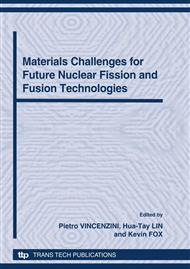p.27
p.36
p.41
p.51
p.59
p.65
p.72
p.78
p.91
Progressive Development for Structural Integrity Quantification of Nuclear Grade Graphite in Very High Temperature Gas Cooled Reactor Core Environments
Abstract:
Graphite is used as a moderator for high temperature gas-cooled reactor (HTGR) because the microstructure ofwithin the graphite can store defect energy (Wigner energy) induced by high-doses radiation. However, typically, there are temperature spikes associated with the random releases of enormous amount of defect energy. The irregular events of temperature spikes subsequently heat up HTGR and risk the HTGR experiencing beyond the designed-limit temperature limitsof HTGR. To further investigate the graphite-microstructure evolution subject to radiation damage, we develop a progressive method. We quantify the structural integrity of nuclear-grade graphite using High-resolution Transmission Electron Microscopy (HRTEM). In this study, the nuclear-grade graphite was first radiated by ion implantation with 3Mev C2+ to simulate the material in a very-high-temperature-gas-cooled-reactor (VHTGR)-core environment. The temperatures were controlled in the ranges of 500~1000oC. After the artificial irradiation, HRTEM analyses were proceeded to quantify the microstructure evolution and we calculated the stored energy within the microstructure of the radiated nuclear-grade graphite via Fast Fourier Transform of HRTEM images. Our results show that, at 600 oC and 3 dpa, the microstructure can store energy up to 136 (cal/g), which can heat the HTGR up to 345 oC.
Info:
Periodical:
Pages:
59-64
Citation:
Online since:
October 2010
Authors:
Price:
Сopyright:
© 2010 Trans Tech Publications Ltd. All Rights Reserved
Share:
Citation:


